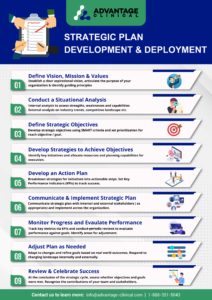
Why Your Clinical Research Organization Needs a Strategic Plan
In the evolving world of clinical research, developing or updating a strategic plan is essential for keeping pace with industry advancements, regulatory changes, and operational challenges. Whether your organization is navigating new regulatory requirements like ICH GCP E6R3, seeking to implement digital transformation, or wanting to optimize clinical trial efficiency, a strategic plan helps align your objectives with market opportunities and regulatory needs. By establishing a clear roadmap, you can optimize resources, improve clinical trial outcomes, and enhance compliance—ensuring your organization remains competitive and agile. For more information on Advantage Clinical’s Strategic consulting services please click here.
What is a Strategic Plan?
A strategic plan is a structured framework that defines your clinical research organization’s vision, mission, and strategic objectives. It serves as a detailed roadmap, aligning every part of the organization towards a shared goal. In clinical research, this can mean enhancing trial operations, improving compliance, building strategic partnerships, or adopting new technologies. By establishing concrete steps for growth and adaptability, a strategic plan ensures your organization’s resources are effectively directed towards improving trial efficiency, ensuring compliance, and achieving long-term success.
Steps to Develop and Execute a Strategic Plan for Clinical Research
1. Define Vision, Mission, and Values
- Vision: Establish a clear, aspirational vision that describes what the organization wants to achieve, such as being a leader in decentralized clinical trials or regulatory compliance.
- Mission: Articulate the purpose of your organization, like improving patient outcomes through high-quality, compliant research.
- Values: Identify guiding principles, such as integrity, collaboration, and patient safety, that drive your clinical research operations and decision-making.
2. Conduct a Situational Analysis
- Internal Analysis: Evaluate current strengths (e.g., experienced staff, advanced eClinical tools), weaknesses (e.g., resource limitations), and capabilities in clinical operations.
- External Analysis: Analyze industry trends, regulatory changes (such as ICH GCP E6R3), competitive landscape, and emerging technologies. Utilize tools like SWOT and PEST analysis to assess how these factors impact your clinical research activities.
3. Define Strategic Objectives
- Set Strategic Goals: Develop SMART objectives focused on areas like improving patient recruitment, enhancing regulatory compliance, or reducing trial timelines.
- Prioritize Goals: Determine which objectives, such as adopting digital technologies or expanding research capabilities, should be prioritized in the short, medium, and long term.
4. Develop Strategies to Achieve Objectives
- Identify Key Initiatives: Define strategies such as integrating eClinical systems, optimizing site management, or enhancing compliance with local regulatory and ICH standards.
- Allocate Resources: Ensure resources (staff, budget, technology) are effectively allocated to initiatives that will have the most significant impact on clinical trial success.
5. Develop an Action Plan
- Define Action Steps: Break down strategies into actionable steps. For instance, implementing new technologies may involve vendor evaluation, pilot testing, and staff training.
- Set Performance Indicators: Establish Key Performance Indicators (KPIs) such as patient recruitment rates, protocol deviation rates, or compliance scores to track the success of each initiative.
6. Communicate & Implement the Strategic Plan
- Communication: Clearly communicate the strategic plan to your team, aligning everyone with key goals such as improving data quality or increasing efficiency.
- Stakeholder Engagement: Engage with external stakeholders, such as regulatory bodies, research sites, and other partners, to align their efforts with your strategic direction.
- Execute Initiatives: Put the plan into action by rolling out initiatives such as new site management processes, technology integrations, or risk mitigation strategies.
7. Monitor Progress and Evaluate Performance
- Track Key Metrics: Use KPIs to monitor progress in areas like regulatory compliance, recruitment rates, and trial efficiency.
- Conduct Reviews: Schedule regular meetings to evaluate performance against goals, identifying areas where the strategy may need adjustments to better align with changing regulatory standards or operational goals.
8. Adjust the Plan as Needed
- Adapt to Changes: The clinical research landscape is always changing. Adapt the plan in response to new regulatory requirements, technological advancements, or internal capacity changes.
- Refine Goals: Adjust goals as necessary based on real-world outcomes and challenges encountered during clinical trial execution.
9. Review and Celebrate Success
- Evaluate Success: At the conclusion of the strategic cycle, assess whether objectives such as compliance improvements or trial efficiency goals were met.
- Acknowledge Achievements: Recognize the contributions of your team and stakeholders in achieving milestones, helping maintain motivation and buy-in for future initiatives.



